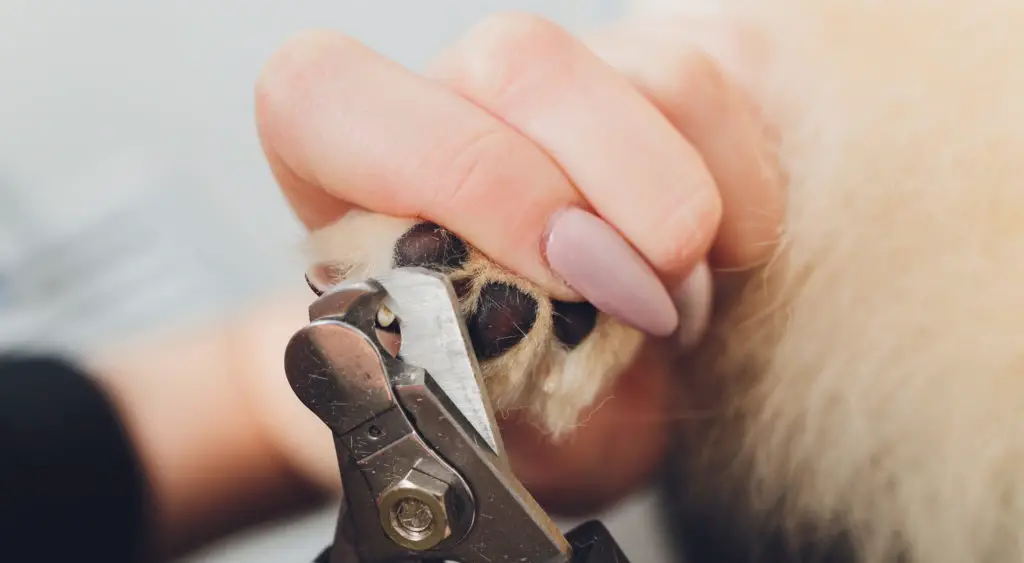This worst thing about long nails on a dog?
As well as scratching your wooden floor to shreds, they can pose a serious threat to the dog’s well-being.
Dog nails tend to grow with a slight downward curve and are extraordinarily strong. If not dealt with, long nails striking the ground can result in immense pressure on the dog's bones and tendons.
The result is not only a lot of discomfort, but may weaken their foot structure over time.
Additionally, longer nails can sometimes break off exposing the sensitive and soft underlying flesh or "quick", which can in and of itself be quite painful.
Smaller dogs have nails that tend to grow in a circle. If their nails are not cared for, they can grow back into the dog's foot pad causing puncture wounds that can be painful and prone to infection.
Checking nails and trimming them from time to time is an absolute must for the vast majority of pet dogs.
How often should my dogs nails be trimmed?
This will vary for each dog based on the dog and their lifestyle. However, most dogs will benefit from getting their nails trimmed every four to six weeks.
If a dog spends a lot of time walking on hard surfaces or they walk up on their pasterns, they will naturally wear down their nails and will probably never need to have them trimmed.
However, for most household pet dogs this is usually the not case.
When the nail extends beyond the paw pad and touches the ground they need a trim.


How to trim the nails
When trimming the dogs' nails you're aiming to cut the nail so that it does not extend beyond the footpad and touch the ground.
If you only cut the tips, the quick continues to grow further out into the nail, making it harder to achieve a short, healthy nail in the long run.

When cutting you should always cut on an angle parallel to the bottom of the nail.
With that in mind, the trimming procedures you should follow vary slightly depending on the color of the nails.
White nails
A white nail is relatively easy to trim because the pink of the quick is easy to see.
All you need to do is place the nail trimmer at the point the pink stops. Once you are at that point make the cut.
Black nails
Trimming black nails is more difficult because the quick is not visible from the outside.
First, take the hook off the nail, then look at the end of the dog's nail.
In the middle of the nail bed, there should be a darker black circle. This darker circle is a blood vessel, but it is not the part that will bleed. Keep cutting small sections until the darker circle covers the majority of the nail bed.
Once enough of the dog's nail has been cut, there will be a small white dot visible at the center. This is as far as can be cut before cutting into the dog's quick.
Once you know the target length for one nail, you can use it as a guide to trim the remaining nails.
Bleeding
Sometimes, especially if this is your first time trimming, you will cut the nail just a little too much, nipping the quick and causing the nail to bleed.
If there's just a little blood, simply applying some pressure using your finger may be enough to stop it.
Otherwise, you will need to apply something like Styptic powder to stop the bleeding.
Sprinkle some product on your finger and then apply it to the end of the dog's nail with some pressure for around 30 seconds. In some cases, a full minute of pressure will be needed to stop the bleeding.
The nail should be checked after bathing and again once the dog has had a day or so to play and exercise. A recently cut nail is susceptible to breaking open and bleeding if the dog comes into contact with hard surfaces such as asphalt or concrete.
If the bleeding is not taken care of, there is a possibility it could start again when the dog's foot gets wet. If this occurs, check the bleeding, and reapply the appropriate product applying more pressure to the dog's nail.
In certain cases, running cold water over the foot can lower the blood flow and stop any bleeding. Another option is to apply flour or cornstarch to the bleeding nail as this will also stop any bleeding.
Receding the quick
If the dogs nails have been neglected for some time, the quick may have lengthened too much to allow trimming to the appropriate nail length.
While quite time consuming, it is possible to encourage the quick to recede.
In the past it was the practice that the quick should be every so slightly cut to cause it to draw back into the nail bed. However, these days evidence suggests that frequent, albeit close, trimming is sufficient to encourage the quick to recede over time.
Essentially, you might start trimming once every week or so, each time cutting a little more off until you reach the target length.

Exposes the soft tissue just before the quick causing it to recede.


